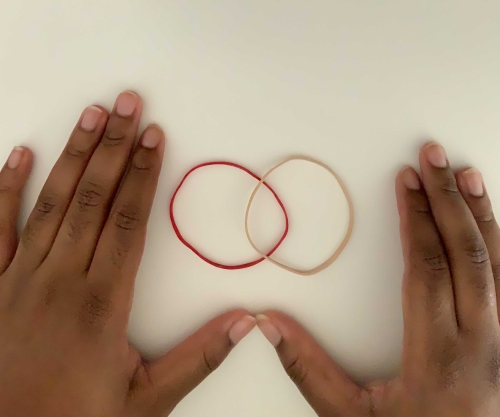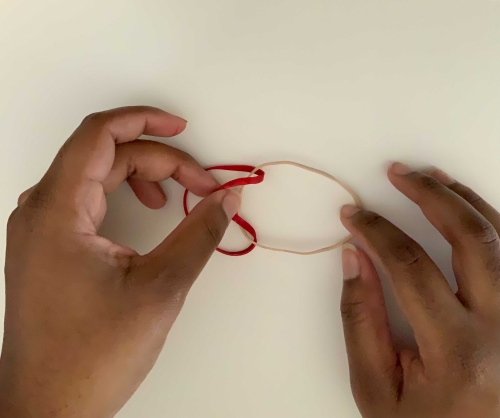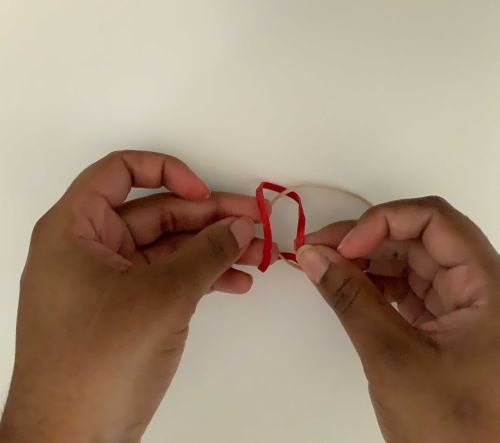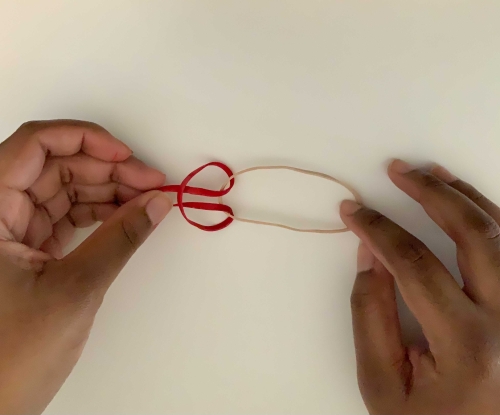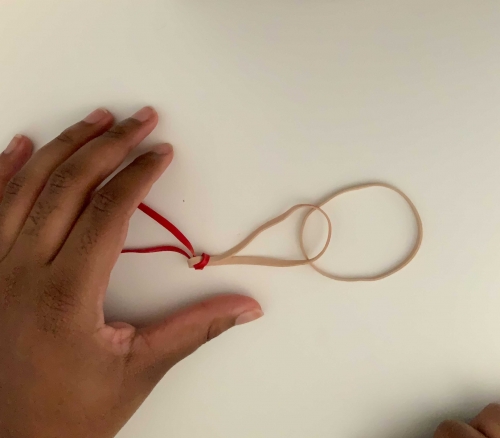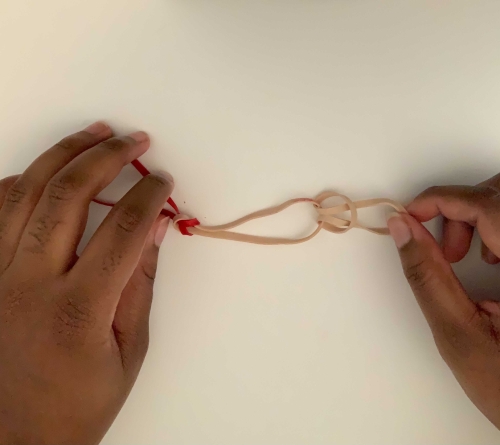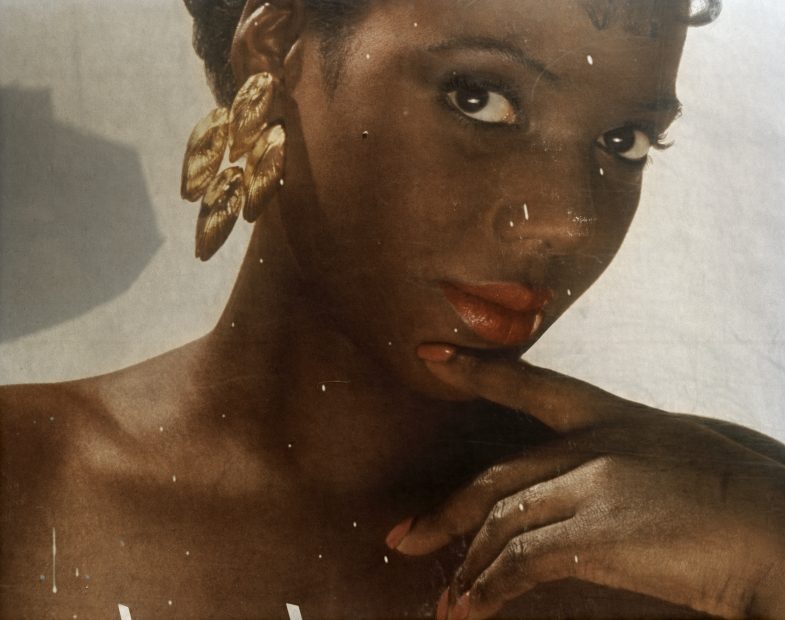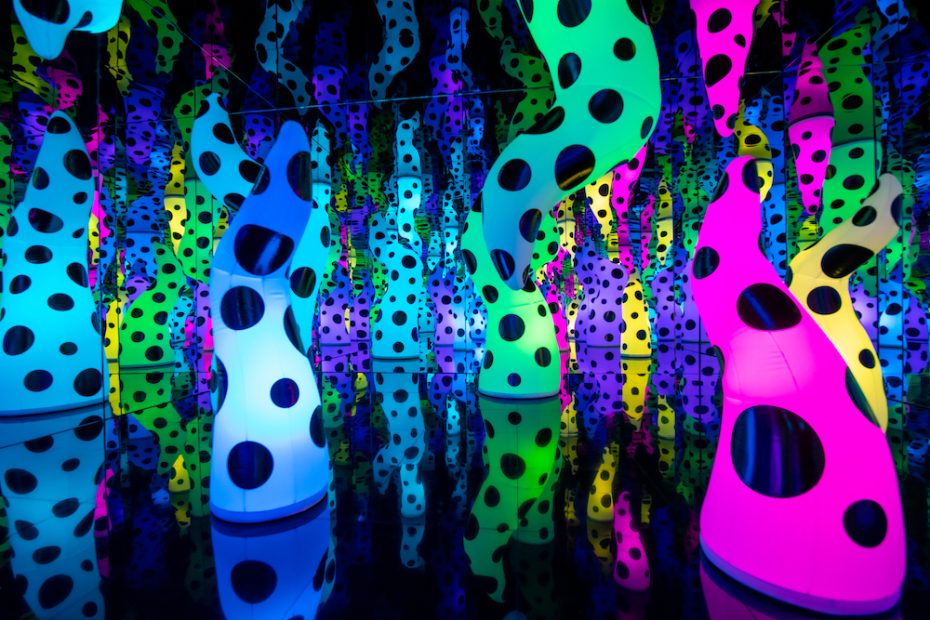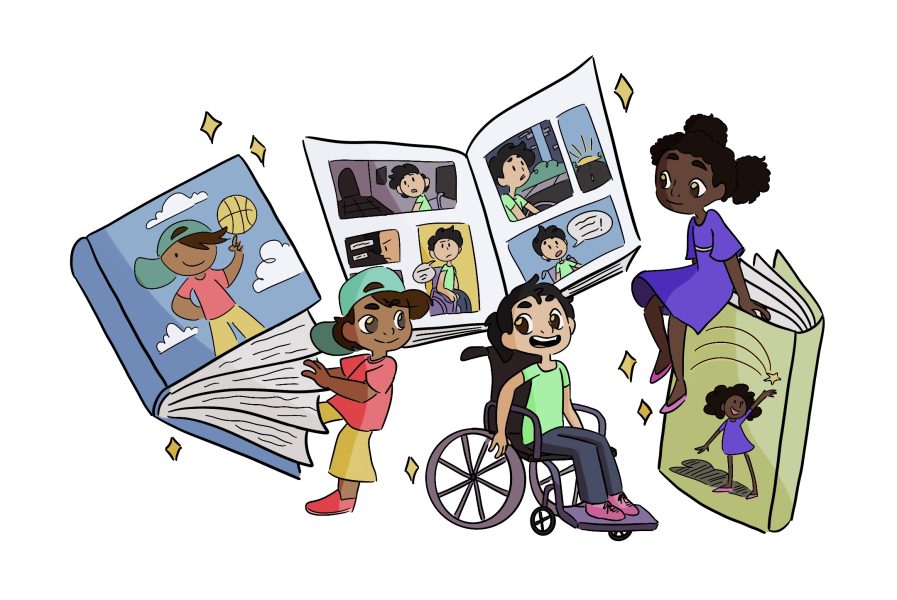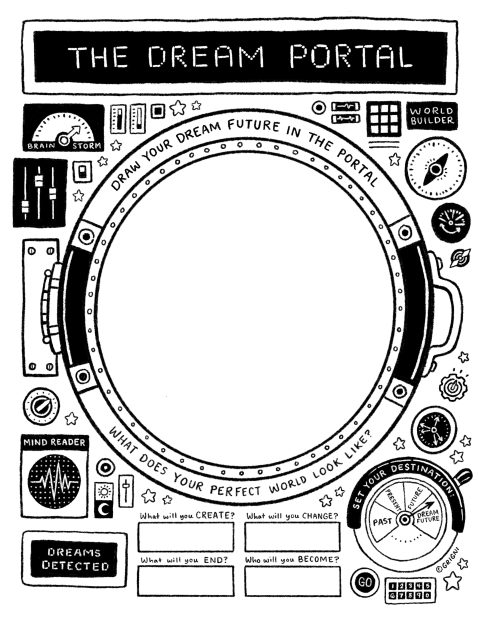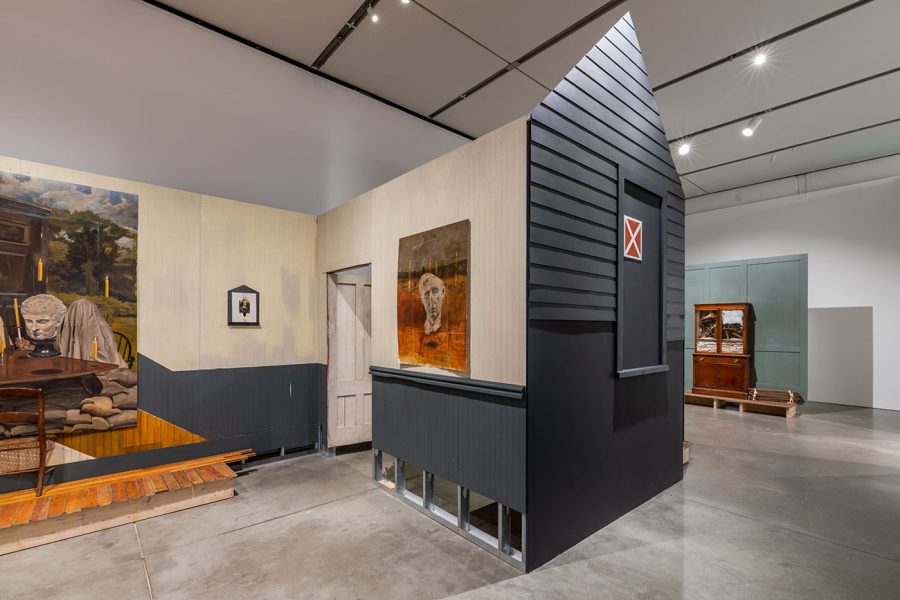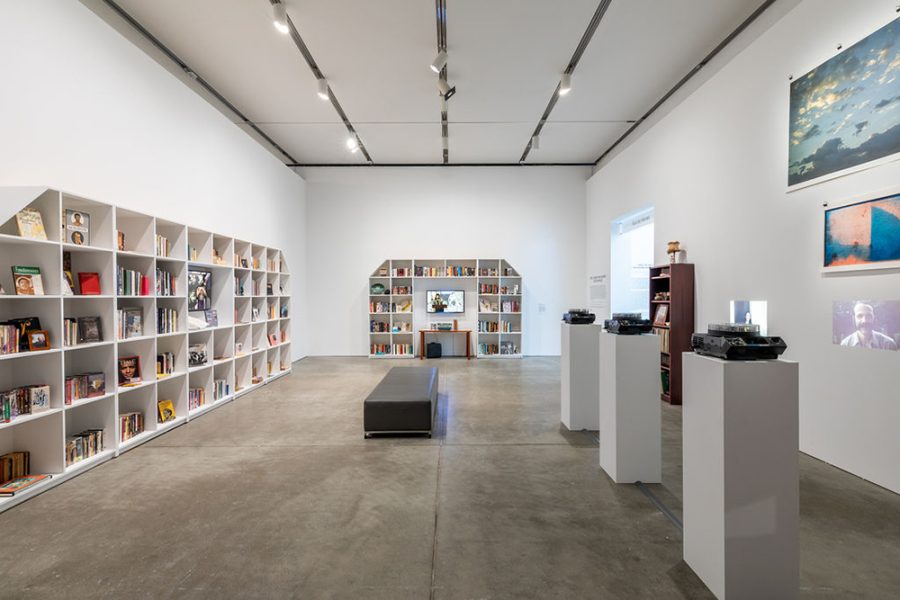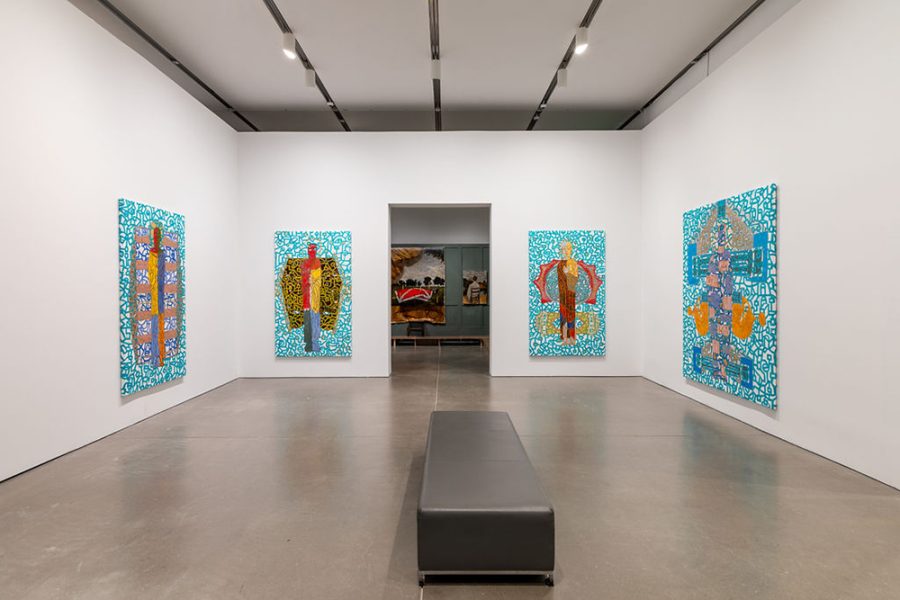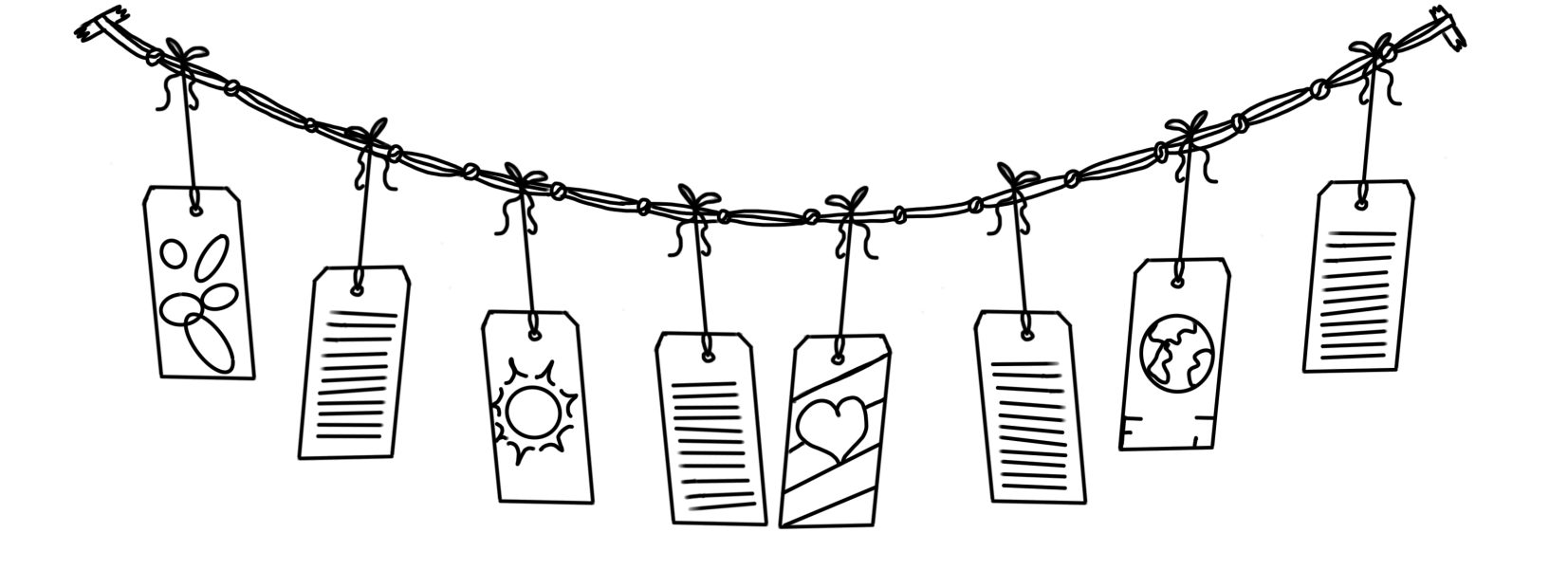
Create a Dream Chain to inspire the world you want to build. What would bring joy? What would make the world a better place for all? Seek inspiration from the ICA exhibition The Worlds We Make: Selections from the ICA Collection, where artists reimagine the world through their perspectives, then dream up a world of your own.
Materials:
Instructions:
1. Link all of your rubber bands together to form a chain. Follow the photos or watch the video below.
a. To start your chain, place one rubber band on a flat surface, this will be band #1 (pictured as red). Place a second band (#2, pictured as beige) to the right of band #1, and slightly overlapping on the right side of band #1.
b. With your right hand, hold down band #2 to keep it from moving. With your left hand pinch the inner side of band #1, and lift it over band #2. Thread it through the loop, pulling it under the outer side of band #1. Pull tight and you have your first loop.
c. Repeat these steps on either the outside edge of band #1 or band #2. Keep repeating these steps until your Dream Chain is the length you want.
2. On individual tags, draw or write about the things that you would like to see in your world. Feel free to use both sides of the tags. To help inspire ideas, try answering the following questions:
Who are some people who make you feel happy?
What is your favorite animal(s)?
Where would you like to visit one day?
What is your favorite food?
What do you like to do in your free time?
If you had a super power, what would it be?
If you could change anything in the world, what would you change?
3. Attach each tag to your rubber band link by tying or taping the tag strings to the rubber bands.
4. Hang your Dream Chain somewhere special to remind you of the world you want to build.
Share your artwork on social media with #ICAartlab!
Find more activities here.
This activity was created by Flolynda Jean, Education Assistant, Studio Programs
Nationally touring exhibition will open at the ICA in November 2021 and travel to MoMA PS1 and the High Museum of Art in 2022
(Boston, MA—October 8, 2021) The Institute of Contemporary Art/Boston (ICA) and MoMA PS1 have co-organized the first museum survey dedicated to the work of Deana Lawson (b. 1979, Rochester, NY), a singular voice in photography today. Drawing on a wide spectrum of photographic languages, including the family album, studio portraiture, staged tableaux, and appropriated images, Lawson’s posed photographs channel broader ideas about personal and social histories, sexuality, and spiritual beliefs. Featuring a selection of over fifty photographs from 2004 to the present, this exhibition features the full range of Lawson’s career to date and establishes for the first time a narrative arc of her expansive vision. This nationally touring exhibition will be on view November 4, 2021–February 27, 2022 at the ICA; April 14–September 5, 2022 at MoMA PS1; and October 7, 2022–February 19, 2023 at the High Museum of Art. Deana Lawson is co-organized by ICA/Boston and MoMA PS1. Organized by Eva Respini, Barbara Lee Chief Curator, ICA/Boston, and Peter Eleey, Curator-at-Large, UCCA Center for Contemporary Art, Beijing and Shanghai, with Anni Pullagura, Curatorial Assistant, ICA/Boston.
“With a painterly appreciation of composition, color, and scale, Deana Lawson creates works of intimacy, atmosphere and mystery. Her domestic scenes evoke the familiarity of family photographs, yet each work is a highly-staged arrangement exploring facets of Black life. Lawson tackles complex issues about race and photography that are timely, thorny, and essential. We look forward to sharing her work, and the important publication that accompanies the exhibition, with audiences,” said Jill Medvedow, the ICA’s Ellen Matilda Poss Director.
“Singular in their vision, profoundly complex in their ideas, Deana Lawson’s pictures possess an intimacy and immediacy that can be both uplifting and startling. Enriched by a range of backstories—photographic histories, feminist histories, Black histories—Lawson’s work is also informed by her life experiences, pop culture, her interest in both spirituality and photographic technology. In occupying a space of multiplicity and ambiguity, this relentlessly adventurous artist has produced some of the most resonant images of our time,” said Eva Respini, the ICA’s Barbara Lee Chief Curator.
Lawson’s pictures are portals to imaginative realms, highly staged, large-format color photographs that depict individuals, couples, and groups in both domestic and public settings, constructing narratives of family, love, intimacy, and desire. Her body of work models a mythical community from across the African and African American diasporas, building an extended family of strangers in living rooms, kitchens and back yards from Brooklyn to New Orleans, Haiti to Ethiopia, and Brazil to the Democratic Republic of Congo. Rather than creating documentary or biographical pictures, Lawson makes images that tell stories to reclaim an expansive Black experience.
“Much of Lawson’s work comes to life in the space between the truth presumed in a photograph and the art of making one, which in her hands becomes a vast and magical universe,” said exhibition co-curator Peter Eleey. “Though revelatory, Lawson’s pictures also draw attention to what the camera cannot capture—and in turn, to the many aspects of Black life that exceed forms of representation that establish and control the ways in which Black subjects are permitted to appear.”
The camera has a long history as a tool of objectification and subjugation, and Lawson uses photography to unsettle assumptions about the facts the medium purports to deliver. She carefully composes each scene, but does not always disclose details about how she has created them, or even where the photographs were taken; in some cases, she works with found images that depict people she does not know. Her tableaux tend to be composed of people she encounters on her travels rather than family, friends, or acquaintances; despite what certain pictures may suggest, some of the artist’s subjects may not have met before the shoot. Lawson finds photography’s contradictions and fraught history to be perfectly suited to the challenges of representing what she describes as “the majesty of Black life, a nuanced Black life, one that is by far more complex, deep, beautiful, celebratory, tragic, weird, strange.”
Artist biography
Deana Lawson (b. 1979, Rochester, NY) lives and works between New York and Los Angeles. Lawson received her B.F.A. from Pennsylvania State University (2001) and M.F.A. from the Rhode Island School of Design (2004). Lawson is the recipient of a Guggenheim Fellowship (2013), Aaron Siskind Fellowship Grant (2008–09), and a New York Foundation for the Arts Grant (2006), among others. In 2020, she was selected for the Hugo Boss Prize, the first photographer to receive the award in recognition of achievement in contemporary art. She is currently the inaugural Dorothy Krauklis ’78 Professor of Visual Arts with the Lewis Center for the Arts at Princeton University.
Catalogue
This survey exhibition will be accompanied by the first scholarly publication on the artist, surveying fifteen years of her photography. Featuring the voices and perspectives of a variety of scholars, historians, and writers, the catalogue includes essays by exhibition curators Eva Respini and Peter Eleey, Kimberly Juanita Brown, Tina M. Campt, Alexander Nemerov, Greg Tate, and a conversation between the artist and Deborah Willis.
Advisory Group
In the process of organizing the exhibition, the ICA convened an advisory group of community leaders, artists, scholars, and peers who contributed to the presentation of this exhibition in Boston and helped to shape exhibition programming, didactics, and outreach. The committee was made up of the following individuals: Eden Bekele, Digital Associate at PICTURESTART; Kimberly Juanita Brown, Associate Professor, Department of English, Dartmouth College; Patricia Davis, Associate Professor, College of Arts, Media, and Design, Northeastern University; Nia Evans, Director, Boston Ujima Project; L’Merchie Frazier, Director of Education, Museum of African American History, Boston; Kai Grant, Principal, Afrikai, LLC, and Chief Curator, Black Market Nubian; Nikki Greene, Assistant Professor of Art, Wellesley College; Dell Hamilton, artist; James Pierre, artist and educator; Lisa Simmons, Director, Roxbury International Film Festival; President/Founder, the Color of Film Collaborative, Inc.; and Community Initiative Program Manager, Mass Cultural Council; and Akili Tommasino, Associate Curator, Modern and Contemporary Art, Metropolitan Museum of Art.
About the ICA
Since its founding in 1936, the ICA has shared the pleasures of reflection, inspiration, imagination, and provocation that contemporary art offers with its audiences. A museum at the intersection of contemporary art and civic life, the ICA has advanced a bold vision for amplifying the artist’s voice and expanding the museum’s role as educator, incubator, and convener. Its exhibitions, performances, and educational programs provide access to the breadth and diversity of contemporary art, artists, and the creative process, inviting audiences of all ages and backgrounds to participate in the excitement of new art and ideas. The ICA is located at 25 Harbor Shore Drive, Boston, MA, 02210. The Watershed is located at 256 Marginal Street, East Boston, MA 02128. For more information, call 617-478-3100 or visit our website at icaboston.org. Follow the ICA at Facebook, Twitter, and Instagram.
Deana Lawson is co-organized by ICA/Boston and MoMA PS1. This exhibition is organized by Eva Respini, Barbara Lee Chief Curator, ICA/Boston, and Peter Eleey, Curator-at-Large, UCCA Center for Contemporary Art, Beijing and Shanghai, with Anni Pullagura, Curatorial Assistant, ICA/Boston.
Major support for Deana Lawson is provided by the Henry Luce Foundation and The Andy Warhol Foundation for the Visual Arts.
Additional support for the ICA/Boston presentation is generously provided by Bridgitt and Bruce Evans, Aedie McEvoy, Kambiz and Nazgol Shahbazi, Kim Sinatra, Charlotte and Herbert S. Wagner III, the Fotene Demoulas Fund for Curatorial Research and Publications, the Jennifer Epstein Fund for Women Artists, and The Kristen and Kent Lucken Fund for Photography.
What do you treasure most? Who do you care about? What places are most special to you? Create miniature artworks inspired by your treasures. Seek inspiration from the fantastical sculptures in the ICA exhibition Raúl de Nieves: The Treasure House of Memory where the artist weaves Mexican sewing traditions with drag, ballroom, and queer club culture.
Materials:
Instructions:
- Think about what you treasure the most. Think beyond objects and include people, places, feelings, and ideas that you treasure or love. Make a list if it helps you brainstorm.
- Create drawings or miniature sculptures that represent each of your treasures. Use any art materials you like to create your treasures. (See the materials list for ideas.) Plan ahead so that your treasures can fit inside your container.
- Place your treasures in a chest or container of your choice. Look at and reflect on them every once in a while.
- Care for your treasures. Share your treasures with others or keep them secret. Over time, you can change or add new treasures to your collection.
Share your artwork on social media with #ICAartlab
Find more activities at icaboston.org/artlab
Tickets on sale to ICA members today and general public September 28
(Boston, MA—September 21, 2021) The Institute of Contemporary Art/Boston (ICA) will reopen Yayoi Kusama’s LOVE IS CALLING to the public on October 16, 2021. One of the most beloved and popular works in the ICA’s collection, LOVE IS CALLING is among the most immersive of the artist’s existing Infinity Mirror Rooms. It will be featured as a cornerstone of the exhibition The Worlds We Make: Selections from the ICA Collection, on view through December 31, 2022. Advance timed tickets are required and can be reserved at icaboston.org/tickets. Tickets are limited and are on sale now for ICA members. Tickets will go on sale to the general public on September 28.
“We are so happy to be able to offer audiences the ability to experience this beloved artwork from our collection and once again share Kusama’s universal message of love and human connection,” said Jill Medvedow, the ICA’s Ellen Matilda Poss Director.
A mirrored landscape, sculptural environment, and unique experience, LOVE IS CALLING immerses visitors within Kusama’s groundbreaking visualization of infinity, a concept the artist understands as the potential for dissolving one’s place in the universe to become connected to others—remaking the world we know through the invitation to dream another.
LOVE IS CALLING illustrates a central idea within the exhibition The Worlds We Make: Selections from the ICA Collection. Including works by artists such as Maria Magdalena Campos-Pons, Njideka Akunyili Crosby, Jeffrey Gibson, Lorraine O’Grady, Matthew Ritchie, and Yinka Shonibare CBE (RA), the exhibition celebrates the world-making potential of artistic imagination. The Worlds We Make is organized by Anni Pullagura, Curatorial Assistant.
About LOVE IS CALLING
Yayoi Kusama (b. 1929, Matsumoto, Japan) is one of the most recognized and celebrated artists today. In addition to her widely popular Infinity Mirror Rooms, Kusama creates vibrant paintings, works on paper, and sculpture with abstract imagery. LOVE IS CALLING features vividly colored, tentacle-like, inflatable sculptures covered with the artist’s signature polka dots and encased in a dark mirrored room to create an illusion of infinite space. As visitors walk throughout the installation, a sound recording of Kusama reciting a love poem in Japanese plays continuously. Written by the artist, the poem’s title translates to Residing in a Castle of Shed Tears in English. Exploring enduring themes including life and death, the poem poignantly expresses Kusama’s hope to spread a universal message of love through her art. The largest of Kusama’s existing Infinity Mirror Rooms, LOVE IS CALLING is the first one held in the permanent collection of a New England museum.
About the ICA
Since its founding in 1936, the ICA has shared the pleasures of reflection, inspiration, imagination, and provocation that contemporary art offers with its audiences. A museum at the intersection of contemporary art and civic life, the ICA has advanced a bold vision for amplifying the artist’s voice and expanding the museum’s role as educator, incubator, and convener. Its exhibitions, performances, and educational programs provide access to the breadth and diversity of contemporary art, artists, and the creative process, inviting audiences of all ages and backgrounds to participate in the excitement of new art and ideas. The ICA is located at 25 Harbor Shore Drive, Boston, MA, 02210. The Watershed is located at 256 Marginal Street, East Boston, MA 02128. For more information, call 617-478-3100 or visit our website at icaboston.org. Follow the ICA on Facebook, Twitter, and Instagram.
|
If you had your own little library, what stories would you include? Books help us explore our identities, the world, and our own imaginations. In this illustration activity, you can design your own artful library and draw three different book covers using the instructions below! |
Si tuvieras tu propia pequeña biblioteca de habilidades y arte, ¿qué historias incluirías en ella? Los libros nos ayudan a indagar sobre nuestra identidad, el mundo y nuestra propia imaginación. En esta actividad de ilustración, puedes diseñar tu propia biblioteca de habilidades y arte, y dibujar tres cubiertas de libros a través de las instrucciones que se indican a continuación. |
Materials/Materiales:
|
|
|||
Instructions / Instrucciones:
|
|
|
Genielysse Reyes is a children’s book author and comic creator currently living in Boston. She loves drawing and writing about imaginary friends, spoken word poets, and FilipinoAmerican magic. You can connect with her on Twitter (@genielyssereyes) and Instagram (@genielysse) |
Genielysse Reyes es autora de libros infantiles y creadora de historietas, y en la actualidad reside en Boston. Le encanta dibujar y escribir acerca de amigos imaginarios, de los poetas que hacen spoken word (palabra hablada) y de la magia filipino-estadounidense. Puedes ponerte en contacto con ella a través de Twitter (@genielyssereyes) e Instagram (@genielysse). |
|
Share your artwork on social media with #ICAartlab |
Comparte tu experiencia en redes sociales con #ICAartlab |
|
*The term freedom dreaming was coined by professor Robin Kelley in 2002, and expanded upon by activists Alicia Garza and Tourmaline. It is now referenced across social movements as a way to envision and enact change. The City University of New York defines freedom dreaming as “a tool that invites us to create the world we dream of by, first, visualizing the future we want to live in, and second, determining the actions that will lead us there.” |
*El término sueño de libertad fue creado por el profesor Robin Kelley en 2002, y divulgado por las activistas Alicia Garza y Tourmaline. En la actualidad, se hace referencia a este término en todos los movimientos sociales como una manera de imaginar y promulgar el cambio. La Universidad de la Ciudad de Nueva York define el sueño de libertad como “una herramienta que nos invita a crear el mundo con el que soñamos, primero, visualizando el futuro que queremos vivir y, segundo, determinando cuáles son las acciones que nos conducirán hasta allí”. |
|
Freedom dreaming* is a way to imagine a better world, and the dream portal invites you to draw that world on paper. To use the dream portal, simply imagine your perfect world, draw it, and start time-traveling towards it. What would you change about the world, if you could change anything? |
Sueño de libertad* es una manera de imaginar un mundo mejor, y el portal de los sueños te invita a dibujar ese mundo en papel. Para entrar en este portal de sueños, tan solo imagina tu mundo perfecto, dibújalo, y comienza a viajar rumbo a él a través del tiempo. Si pudieras cambiar algo en el mundo, ¿qué sería? |
Materials/Materiales:
|
|
|||
Instructions / Instrucciones:
By imagining the changes you want to see in the world, you take the first step towards making them. By dreaming of a better future and sharing those dreams, you invite others to dream alongside you. Thanks to you, we are one step closer to building a better world together! |
Cuando sueñas con un futuro mejor y compartes esos sueños, invitas a los demás a soñar junto a ti. ¡Gracias a ti, estamos un paso más cerca de crear juntos un mundo mejor! |
|
Noah Grigni is a children’s book illustrator and trans activist, living and dreaming in Boston. You can see their art at noahgrigni.com or on Instagram @noahgrigni. |
Noah Grigni trabaja ilustrando libros para niños y es activista trans. Vive y sueña en Boston. Puedes ver su arte en noahgrigni.com o en Instagram @noahgrigni. |
|
Share your artwork on social media with #ICAartlab |
Comparte tu experiencia en redes sociales con #ICAartlab |
|
*The term freedom dreaming was coined by professor Robin Kelley in 2002, and expanded upon by activists Alicia Garza and Tourmaline. It is now referenced across social movements as a way to envision and enact change. The City University of New York defines freedom dreaming as “a tool that invites us to create the world we dream of by, first, visualizing the future we want to live in, and second, determining the actions that will lead us there.” |
*El término sueño de libertad fue creado por el profesor Robin Kelley en 2002, y divulgado por las activistas Alicia Garza y Tourmaline. En la actualidad, se hace referencia a este término en todos los movimientos sociales como una manera de imaginar y promulgar el cambio. La Universidad de la Ciudad de Nueva York define el sueño de libertad como “una herramienta que nos invita a crear el mundo con el que soñamos, primero, visualizando el futuro que queremos vivir y, segundo, determinando cuáles son las acciones que nos conducirán hasta allí”. |
(Boston, MA—August 12, 2021) The Institute of Contemporary Art/Boston (ICA) presents the 2021 James and Audrey Foster Prize exhibition with major works on view from Boston-area artists Marlon Forrester (b. 1976, Georgetown, Guyana), Eben Haines (b. 1990, Boston), and Dell Marie Hamilton (b. 1971, New York). This group of artists works in a diversity of media, including collage, painting, performance, photography, sculpture, and installation, with unique artistic practices that share the impulse to explore questions of identity and history in the present to create connections with others and articulate their place in the world. On view September 1, 2021 through January 30, 2022, this exhibition is organized by Jeffrey De Blois, Assistant Curator and Publications Manager.
“We are grateful to Jim and Audrey Foster for their generous support which allows the museum the time and resources for the research and presentation of this important biennial exhibition,” said Jill Medvedow, the Ellen Matilda Poss Director of the ICA. “The works of Marlon Forrester, Eben Haines, and Dell Marie Hamilton help illuminate ways forward—and the need for community—in our complex time.”
“The 2021 Foster Prize artists illustrate the creativity, vitality, and expertise of Boston’s artistic community,” the Fosters added. “We congratulate Marlon, Eben, and Dell on this well-deserved achievement and look forward to seeing their work shared with all visitors to the ICA.”
This year’s iteration of the Foster Prize is the result of research made through sustained and ongoing conversations with artists and art workers about their perspectives on the cultural fabric of the city and the different institutions and histories that continue to inform artists working locally. The individual projects composing the 2021 James and Audrey Foster Prize exhibition draw on these perspectives to explore themes of memory, appropriation, inequity, and exchange, as well as intergenerational artistic legacies unique to Boston.
First established in 1999, the James and Audrey Foster Prize is key to the ICA’s efforts to support artists working in and around Boston, showcase exceptional artwork, and support the city’s thriving arts scene.
The exhibition begins with Marlon Forrester’s If Black Saints Could Fly 23: si volare posset nigra XXIII sanctorum, a new cycle of monumental paintings that begins with associations between ideas of flight, resistance, and freedom in the legend of Flying Africans, popular folktales about enslaved Africans harnessing the power of flight to return home. Forrester’s approach is framed conceptually by his notion of “psychic homeland,” his multilayered sense of identity, belonging, and disequilibrium as a Guyanese American of the Caribbean diaspora. Each painting in the cycle features a frontally posed figure rendered with graphic flatness over an intricate allover pattern (which is made from the geometric shapes found on basketball courts). These figures take their iconic poses and trappings of saints and biblical figures largely from sculptures that decorate the ornate portals on the Cathedral of Our Lady of Chartres in France. Beyond replacing conventionally white figures with those historically denied such veneration, he subverts these very traditions by incorporating a multiplicity of overlapping cultural influences. The complexity of experience inscribed in each painting aims to counter historical exclusions and marginalization by centering the Black male body as a site of celebration, commemoration, and transformation.
The next gallery presents Eben Haines’s Facades, a sculptural stage set built to display works that take up different notions of shelter as necessity or commodity. The set evokes forms of New England architecture, such as the gable roof, with distressed walls that call to mind the rooms of lived-in homes fallen into disrepair. In one section, natural or supernatural phenomena recur across paintings of New England landscapes, at times presented on or in domestic furniture. In another section, representations of Roman portrait busts—such as the Forbes Augustus or the Nelson Head in the collection of the Museum of Fine Arts, Boston—stand in for the corrupting force of unchecked power. Candles, either burning in paintings or recently extinguished on wall fixtures, appear to signal that time is running out, or that we are on borrowed time. Born out of ideas refined through Shelter In Place Gallery, a scale model gallery that has featured local artists throughout the pandemic, Facades is an imaginary interior space where illusion is a means for challenging structures of power and exclusion.
The final gallery presents Dell Marie Hamilton’s The End of Susan, The End of Everything, a multimedia installation encompassing Hamilton’s work with hundreds of possessions of the late art historian, Susan Denker, a longtime faculty member at the School of the Museum of Fine Arts. When Denker passed away unexpectedly in 2016, Hamilton inherited her friend and mentor’s many belongings. A room-filling work in three sections, The End of Susan, The End of Everything is modeled on the living room, study, and bedroom of Denker’s former Cambridge apartment. The installation—which aims to “map the unmappable,” according to the artist—enacts a creative exchange between the two individuals pointed at making a layered portrait of Denker rooted in their relationship, Hamilton’s own history and lived experience, and, frequently, her body. By engaging with the complex and innumerable material traces of Denker’s life and using her own body as a medium, Hamilton attempts to answer the question: How do we make meaning out of what is left behind after someone dies?
Artist Biographies
Marlon Forrester (b. 1976, Georgetown, Guyana) is an artist and educator whose artworks take the representations and uses of the Black male body as a central concern. Forrester’s work explores ideas of ritual and transformation, often through themes and motifs drawn from basketball culture. Following an influential return visit to Guyana, Forrester’s work increasingly examines the instability of identity and complex ideas of homeland for individuals of the Caribbean diaspora. Forrester holds a BFA from the School of the Museum of Fine Arts, Boston and an MFA from Yale University. Forrester holds a BFA from the School of the Museum of Fine Arts at Tufts University and a MFA from Yale University. He is a resident artist at the African-American Master Artist Residence Program (AAMARP) at Northeastern University. His work has been exhibited at such venues as University Hall Gallery, UMass Boston; Museum of Fine Arts, Boston; Edward M. Kennedy Institute for the United States Senate, Boston; the Ethelbert Cooper Gallery of African & African American Art, Harvard University; 808 Gallery, Boston University; Ajira, a Center for Contemporary Art, Newark, NJ; Montserrat College of Art Gallery, Beverly, MA; and the Museum of the National Center for Afro American Artists, Roxbury.
Eben Haines (b. 1990, Boston) investigates the life of objects and their contexts through works that challenge the authority of history by emphasizing its constructed nature. Haines employs various techniques and materials to suggest the passage of time, volatility, and degradation. Many works explore the conventions of portraiture, picturing lone, unidentifiable sitters against cinematic backdrops or in otherworldly scenes. Recent works consider themes of housing and access to art during the pandemic, especially his project Shelter In Place Gallery, an artist-run, 1:12 scale model gallery. Haines holds a BFA from Massachusetts College of Art and Design. His work has been shown at such venues as 13forest Gallery, Arlington, MA; AREA Gallery, Boston; Aviary Gallery, Jamaica Plain; Boston Center for the Arts; and Grin Gallery, Providence. In 2018, Haines received a Massachusetts Cultural Council Artist Fellowship in Drawing. Shelter In Place Gallery received a Transformative Public Art grant from the City of Boston Mayor’s Office of Arts and Culture and the original model was recently acquired by the Museum of Fine Arts, Boston.
Dell Marie Hamilton (b. 1971, New York) is a multidisciplinary artist, independent curator, and archivist who uses the body—often her own—to investigate themes of memory, gender, and history. With roots in Central America and the Caribbean, Hamilton’s work frequently draws upon the personal experiences of her family as well as the folkloric traditions and histories of that region. Hamilton holds a BA in journalism from Northeastern University and a MFA from the School of the Museum of Fine Arts, Boston. She has frequently presented her work at venues around New England, including Stone Gallery, Boston University; the Museum of Fine Arts, Boston; Hood Museum of Art, Dartmouth College, Hanover, NH; and Clark Art Institute, Williamstown, MA, where she became the first visual artist to present a performance artwork in their galleries. Her most recent curatorial project, Nine Moments for Now, which was presented at the Ethelbert Cooper Gallery of African and African American Art at Harvard, was ranked by Hyperallergic as one of 2018’s top 20 exhibitions in the U.S. In 2019, she presented work in the 13th Havana Biennial in Matanzas, Cuba. Along with her collaborator, Magda Fernandez, Hamilton is part of the U.S. Latinx Art Forum’s 2021 inaugural cohort of recipients of the Charla Fund, a Ford Foundation-sponsored initiative that provides grants to Latinx artists. A frequent performer in the work of María Magdalena Campos-Pons, Hamilton appears in Campos-Pons’s collaborative performance When We Gather, which includes poetry and choreography from artists LaTasha N. Nevada Diggs and Okwui Okpokwasili. She is currently at work on a variety of research and curatorial projects at Harvard’s Hutchins Center for African and African American Research.
About the ICA
Since its founding in 1936, the ICA has shared the pleasures of reflection, inspiration, imagination, and provocation that contemporary art offers with its audiences. A museum at the intersection of contemporary art and civic life, the ICA has advanced a bold vision for amplifying the artist’s voice and expanding the museum’s role as educator, incubator, and convener. Its exhibitions, performances, and educational programs provide access to the breadth and diversity of contemporary art, artists, and the creative process, inviting audiences of all ages and backgrounds to participate in the excitement of new art and ideas. The ICA is located at 25 Harbor Shore Drive, Boston, MA, 02210. The Watershed is located at 256 Marginal Street, East Boston, MA 02128. For more information, call 617-478-3100 or visit our website at icaboston.org. Follow the ICA on Facebook, Twitter, and Instagram.
The 2021 James and Audrey Foster Prize exhibition and prize are generously endowed by James and Audrey Foster.




